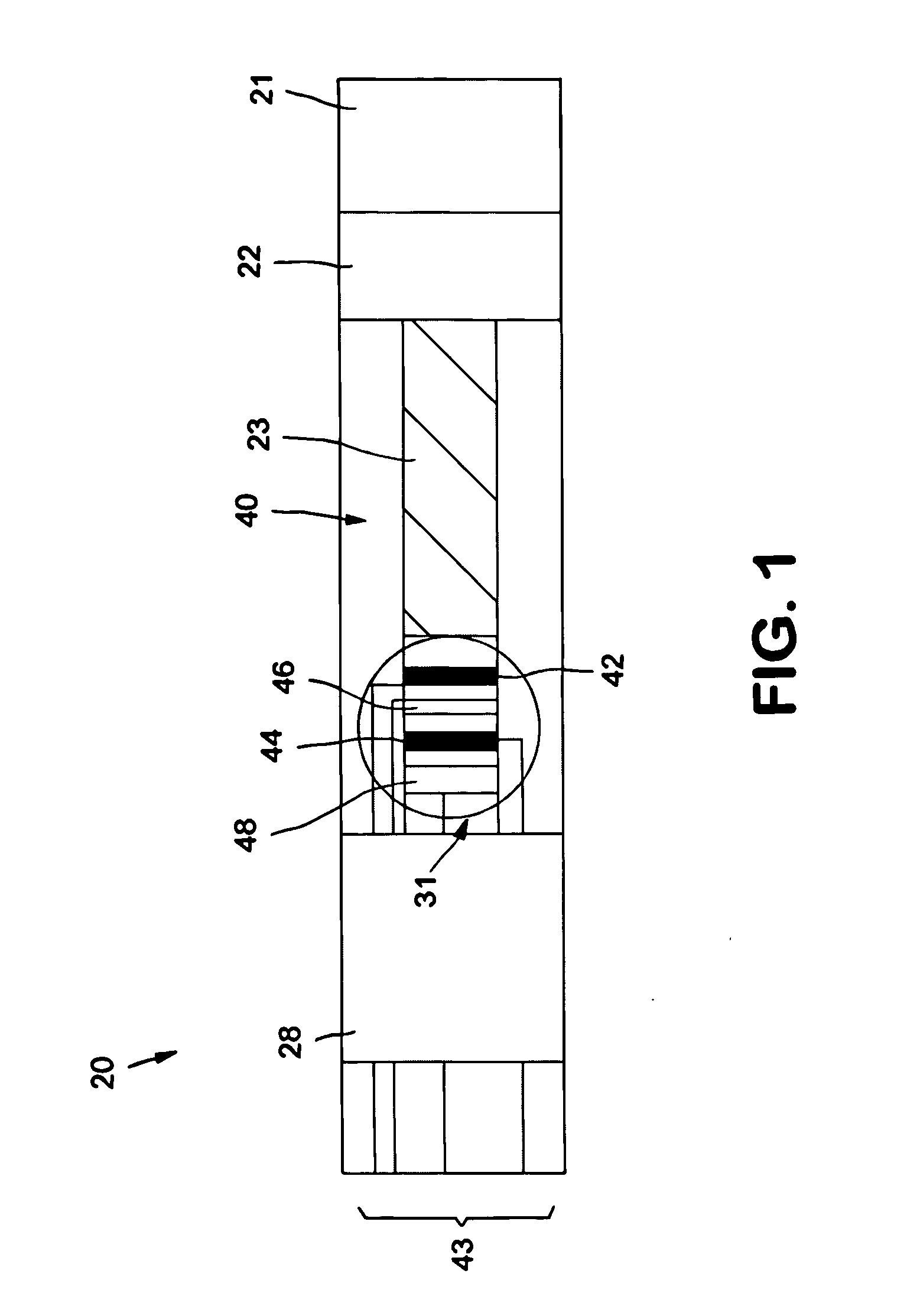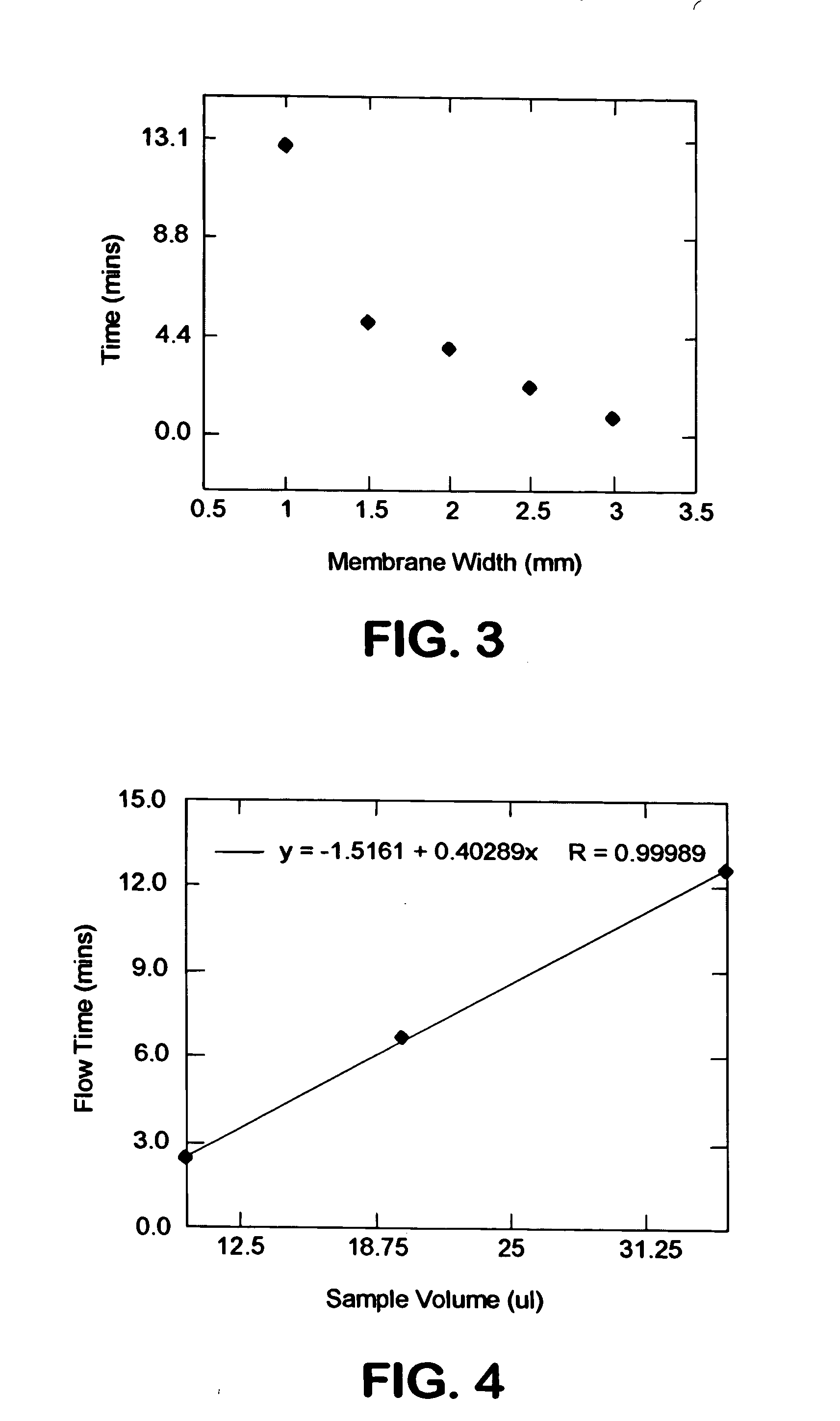Flow control of electrochemical-based assay devices
a flow control and electrochemical technology, applied in the direction of measurement devices, biochemical equipment and processes, instruments, etc., can solve the problems of lowering affecting the sensitivity of the biosensor, and consuming too much time for analyte to adequately mix
- Summary
- Abstract
- Description
- Claims
- Application Information
AI Technical Summary
Problems solved by technology
Method used
Image
Examples
example 1
[0062] Electrodes were printed onto Mylar® substrates obtained from DuPont. The substrates had a width of 1.5 centimeters and a length of 4.5 centimeters. Carbon (7101 or 7102), silver (5000), and silver / silver chloride (5847) inks were obtained from DuPont Biosensor Group of Research Triangle Park, North Carolina. For printing the inks, a screen frame was first fixed onto a screen frame holder and adjusted. Initially, a silver ink line was printed on the substrates to enhance the conductivity between the leads and electrodes to be printed. Thereafter, carbon ink was printed over the silver ink line to form a detection working electrode and a counter electrode. The silver / silver chloride ink was printed onto the substrates to form a reference electrode. Leads for the electrodes were then printed. Insulation of the leads was achieved by printing a layer of UV curable dielectric ink, available from DuPont Biosensor Group under the name “5018G.” The insulation layer essentially covered...
example 2
[0063] Membrane strips of a nylon mesh membrane (11 mesh size, commercially available from Millipore Corp. of Billerica, Mass.) were provided that had a width ranging from 3.5 to 4.5 centimeters and a length of 15 centimeters. To the bottoms of the strips, two glass fiber pads (sample and conjugate pads) were attached using tape. The conjugate pad was in direct contact with the membrane, and the sample pad was in direct contact with the conjugate pad. The conjugate pad was treated with 3 microliters of LH-α-HRP monoclonal antibody conjugate (5 micrograms per milliliter in PBS buffer) and dried for 30 minutes. The LH-α-HRP monoclonal antibody conjugate was obtained from Fitzgerald Industries Int'l of Concord, Mass. The membrane strips were placed onto a sampling instrument commercially available from Kinematic Automation of Twain Harte, Calif. under the name “Matrix 2210 (Universal Laminator).” Thereafter, the strips were cut into individual strips having a width ranging from 1 to 10...
example 3
[0064] The ability to control the flow of a test sample in accordance with the present invention was demonstrated. Specifically, membrane strips of Example 2 were provided that had a width ranging from 1 to 3 millimeters. In addition, electrode strips of Example 1 were provided. The membrane strips were attached onto the surface of the electrode strips so that the membrane and electrode strips were parallel. A wicking pad was also attached downstream from the electrodes having a length of 1 centimeter and a width of 1.5 centimeters. The strips and wicking pad were attached using a covering tape that allowed the test sample to flow to the electrodes through a path defined by the membrane. The covering tape had a length of 3 centimeters and a width of 1.5 centimeters, and is commercially available from Adhesives Research, Inc. of Glen Rock, Pa. under the name “ARcare®.” Once formed, a test sample having a volume of 35 microliters was applied to the sample pad of each strip. The test s...
PUM
| Property | Measurement | Unit |
|---|---|---|
| volume | aaaaa | aaaaa |
| volume | aaaaa | aaaaa |
| volume | aaaaa | aaaaa |
Abstract
Description
Claims
Application Information
 Login to View More
Login to View More - R&D
- Intellectual Property
- Life Sciences
- Materials
- Tech Scout
- Unparalleled Data Quality
- Higher Quality Content
- 60% Fewer Hallucinations
Browse by: Latest US Patents, China's latest patents, Technical Efficacy Thesaurus, Application Domain, Technology Topic, Popular Technical Reports.
© 2025 PatSnap. All rights reserved.Legal|Privacy policy|Modern Slavery Act Transparency Statement|Sitemap|About US| Contact US: help@patsnap.com



